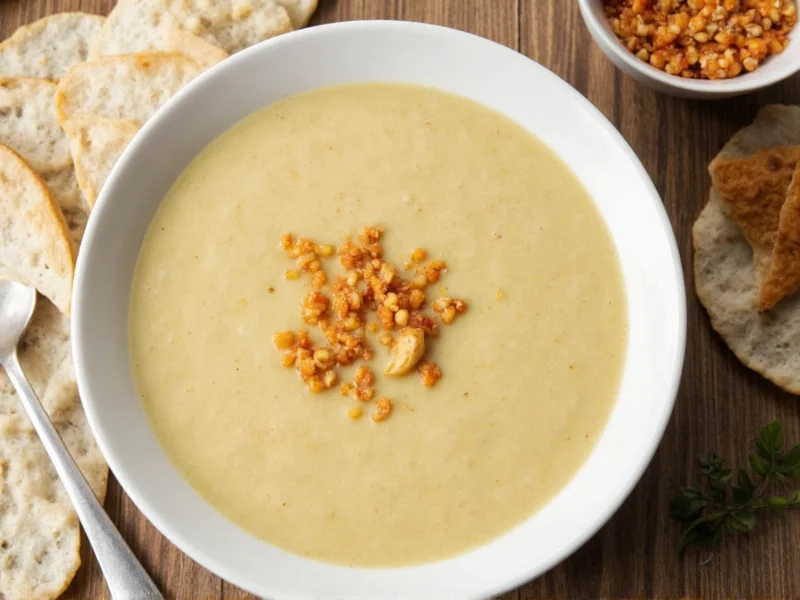Understanding whether cream of chicken soup is gluten free requires careful label examination and brand awareness. This staple pantry item presents unique challenges for those managing celiac disease or gluten sensitivity, as traditional recipes almost always include gluten-containing thickeners. The good news is that gluten-free alternatives have become increasingly available as dietary awareness grows.
Why Most Cream of Chicken Soup Contains Gluten
Cream of chicken soup relies on thickeners to achieve its characteristic consistency. Historically, wheat flour has been the go-to thickening agent in commercial production due to its effectiveness and low cost. This makes standard versions of condensed cream of chicken soup gluten free status problematic for gluten-sensitive individuals.
The manufacturing process for traditional cream of chicken soup typically involves:
- Roux preparation using wheat flour and fat
- Addition of chicken stock and flavorings
- Emulsification with dairy components
- Canning and sterilization
That initial roux step is where gluten enters the equation. Without specific formulation changes, is store-bought cream of chicken soup gluten free almost always yields a negative answer.
Gluten-Free Cream of Chicken Soup Brand Comparison
| Brand | Gluten Status | Notes |
|---|---|---|
| Progresso Traditional | Contains gluten | Wheat flour listed in ingredients |
| Progresso Free & Easy | Gluten-free | Certified gluten-free line |
| Health Valley Organic | Gluten-free | No wheat-based thickeners |
| Swanson Classic | Contains gluten | Uses wheat flour as thickener |
| Swanson Gluten Free | Gluten-free | Specifically formulated version |
| Homemade versions | Variable | Depends on thickener used |
Reading Labels for Gluten-Free Assurance
When determining is canned cream of chicken soup gluten free, focus on these critical label elements:
Certification logos - Look for the Gluten-Free Certification Organization (GFCO) seal or other recognized certification that ensures products contain less than 20ppm gluten, the threshold considered safe for most people with celiac disease.
Ingredient scrutiny - Watch for these potential gluten sources:
- Wheat flour
- Malt flavoring (usually from barley)
- Soy sauce or teriyaki sauce
- Modified food starch (unless specified as corn, potato, or tapioca)
- “Natural flavors” from gluten-containing sources
Manufacturing statements - “May contain wheat” or “Processed in a facility that also processes wheat” warnings indicate potential cross-contamination risks that matter for severe sensitivities.
Creating Truly Gluten-Free Cream of Chicken Soup
For complete control over ingredients, making your own homemade gluten free cream of chicken soup ensures safety. This simple recipe yields a reliable alternative:
Basic Gluten-Free Cream of Chicken Recipe
- 2 tbsp gluten-free flour blend or cornstarch
- 2 tbsp butter or dairy-free alternative
- 1 cup chicken broth (gluten-free certified)
- 1/2 cup cooked chicken, finely diced
- 1/2 cup milk or unsweetened dairy alternative
- Salt, pepper, and herbs to taste
Instructions: Create a slurry with the gluten-free flour and 2 tablespoons of cold broth. Melt butter in a saucepan, add the slurry, and cook for 2 minutes. Gradually whisk in remaining broth, then add chicken and milk. Simmer until thickened (about 10 minutes). Season to taste.
This approach eliminates uncertainty about is cream of mushroom soup gluten free or other condensed soup varieties, as you control every ingredient. The same method works for creating gluten-free versions of cream of mushroom, celery, or other condensed soups.
Special Considerations for Severe Gluten Sensitivity
For those with celiac disease or extreme sensitivity, additional precautions are necessary beyond just checking the cream of chicken soup gluten free label information:
Cross-contamination prevention - Even products labeled gluten-free can become contaminated during manufacturing if facilities process both gluten-containing and gluten-free products. Look for brands that maintain dedicated gluten-free production lines.
Oats clarification - Some gluten-free products use oats, which 1% of people with celiac disease cannot tolerate. If you're highly sensitive, verify whether oats appear in the ingredients.
Restaurant caution - When eating out, assume standard cream of chicken soup contains gluten unless specifically confirmed otherwise. Many restaurants use traditional condensed soups as bases for casseroles and sauces.
Gluten-Free Substitutes in Cooking
Understanding is Campbell's cream of chicken soup gluten free matters when following recipes that call for this ingredient. When adapting traditional recipes:
- Use equal parts gluten-free cream of chicken soup in casseroles
- For gravy bases, substitute with gluten-free roux
- In baking applications, consider dairy-free alternatives if needed
- When thickening soups, use arrowroot or potato starch instead of wheat flour
Many classic recipes like chicken pot pie, green bean casserole, and comfort food casseroles traditionally rely on condensed cream soups. Knowing which gluten free cream of chicken soup brands work as direct substitutes opens up these dishes to gluten-sensitive cooks.











 浙公网安备
33010002000092号
浙公网安备
33010002000092号 浙B2-20120091-4
浙B2-20120091-4